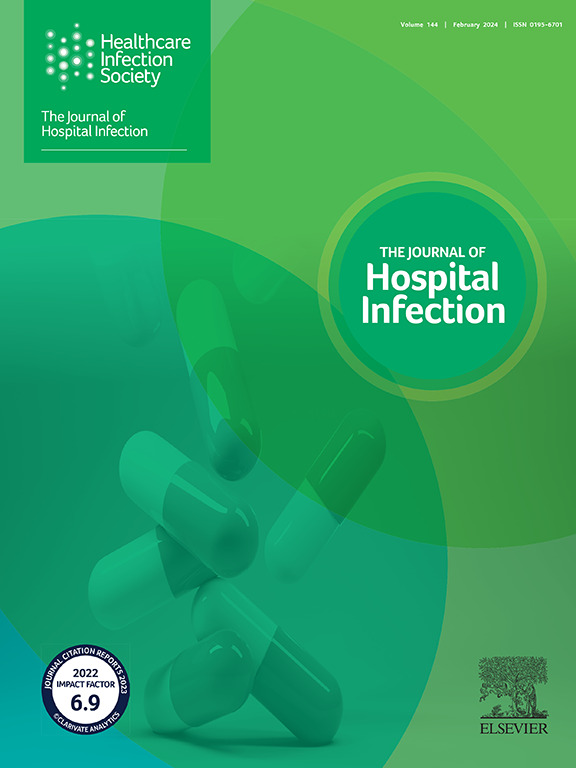新加坡一家急诊三级医院的新生儿重症监护室爆发了肉豆蔻沙雷氏菌疫情。
IF 3.9
3区 医学
Q1 INFECTIOUS DISEASES
引用次数: 0
摘要
目的报告新生儿患者感染或定植马氏沙雷氏菌(S. marcescens)疫情的流行病学、诊断和遗传学调查,包括感染控制干预措施:疫情调查报告。地点:新加坡一家急症护理三级医院的新生儿科,共设有 28 张病床,分为三个区域:两个负压空气传播感染隔离室和一个共用前厅、10 张新生儿重症监护室病床和 16 张高度依赖病床:此次疫情共涉及五名新生儿:方法:对飞行中的患者及其周围环境进行 S. marcescens 筛查,以确定可能的环境来源,对所分离的菌株进行全基因组测序 (WGS) 分析,以确定克隆相关性和可能的传播模式。感染控制干预措施的实施包括及时隔离病例、加强设备和环境消毒、使用酒精擦手液作为首选的手部卫生方式、加强对家长的感染预防指导、审查做法、审计以及对违规行为的即时反馈:结果:此次疫情共涉及五名感染或定植了马氏菌的新生儿。其中四例为感染病例,一例是通过接触追踪发现的。新生儿重症监护室的三个水槽和配奶室的水槽经检测均对马氏菌呈阳性反应。WGS 证实,新生儿重症监护室的两个水槽和配奶室的水槽中的菌株与五名新生儿的菌株具有克隆性:结论:需要采取多管齐下的策略来控制疫情。WGS 分析表明水槽中的生物膜与疫情有关。本文章由计算机程序翻译,如有差异,请以英文原文为准。
Serratia marcescens outbreak at a neonatal intensive care unit in an acute care tertiary hospital in Singapore
Background
Serratia marcescens is an aerobic Gram-negative Enterobacterales bacillus that has emerged as a cause of hospital-associated infections.
Aim
To report the epidemiological, diagnostic, and genetic investigation of an outbreak involving five neonatal patients infected or colonized with S. marcescens including the infection control interventions.
Methods
The outbreak occurred in a 28-bedded neonatal unit in an acute care tertiary hospital in Singapore divided into three areas: two negative-pressure airborne infection isolation rooms with a shared anteroom, 10 neonatal intensive care unit (NICU) beds, and 16 high-dependency beds. In-flight patients and their immediate environment were screened for S. marcescens to determine probable environmental sources. Whole-genome sequencing (WGS) analysis of resulting isolates was performed to determine clone relatedness and possible transmission patterns. Implementation of infection control interventions included prompt isolation of cases, enhanced equipment and environmental disinfection, use of alcohol-based hand rub as the preferred hand hygiene mode, enhanced infection prevention orientation for parents, review of practices, audits, and immediate feedback on non-compliance.
Findings
Five neonates infected or colonized with S. marcescens were involved in this outbreak. Four were infection cases and one was identified through contact tracing. Three NICU sinks and the milk preparation room sink were tested positive for S. marcescens. WGS confirmed clonality of strains from two NICU sinks, and milk preparation room sink with that of the five neonates.
Conclusion
A multi-prong strategy was required to contain this outbreak. WGS analysis showed association of biofilms in sinks with the outbreak.
求助全文
通过发布文献求助,成功后即可免费获取论文全文。
去求助
来源期刊

Journal of Hospital Infection
医学-传染病学
CiteScore
12.70
自引率
5.80%
发文量
271
审稿时长
19 days
期刊介绍:
The Journal of Hospital Infection is the editorially independent scientific publication of the Healthcare Infection Society. The aim of the Journal is to publish high quality research and information relating to infection prevention and control that is relevant to an international audience.
The Journal welcomes submissions that relate to all aspects of infection prevention and control in healthcare settings. This includes submissions that:
provide new insight into the epidemiology, surveillance, or prevention and control of healthcare-associated infections and antimicrobial resistance in healthcare settings;
provide new insight into cleaning, disinfection and decontamination;
provide new insight into the design of healthcare premises;
describe novel aspects of outbreaks of infection;
throw light on techniques for effective antimicrobial stewardship;
describe novel techniques (laboratory-based or point of care) for the detection of infection or antimicrobial resistance in the healthcare setting, particularly if these can be used to facilitate infection prevention and control;
improve understanding of the motivations of safe healthcare behaviour, or describe techniques for achieving behavioural and cultural change;
improve understanding of the use of IT systems in infection surveillance and prevention and control.
 求助内容:
求助内容: 应助结果提醒方式:
应助结果提醒方式:


